Philip’s Royal Tomb was discovered in 1977 in Vergina, Greece. Vergina/Aigai has become a significant place in the debate about who were the ancient Macedonians and also which land and people we can actually call “Macedonian” today.
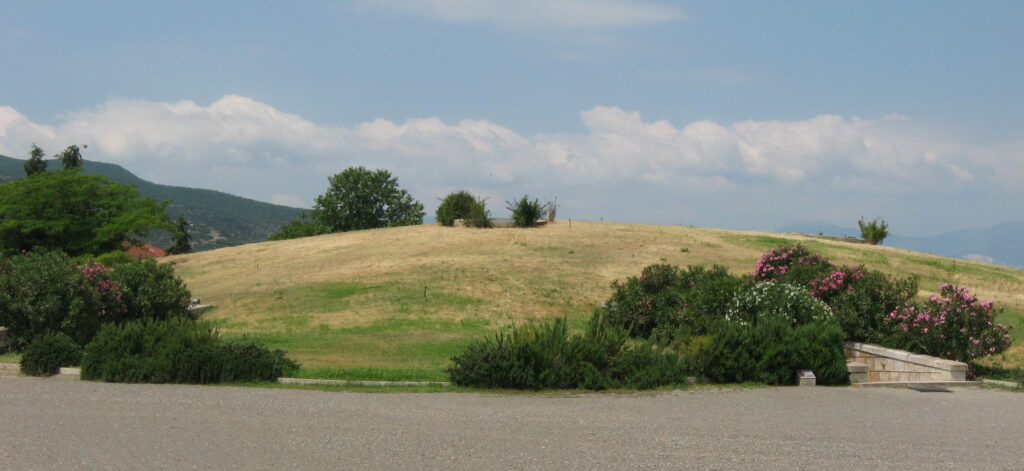
Image source: https://commons.wikimedia.org/wiki/File:Vergina_–_Tombs_of_Philip_II_and_Alexander_IV.jpg
Who was Philip II ?
Philip II of Macedon was a famous king of Macedon kingdom during the period from 359 BC until 336. He was the third son of King Amyntas III of Macedon and a member of the king dynasty of Macedon. During his life king Philip restored internal peace to his country and also gained domination over all of Greece by military and diplomatic means. Philip II is described as a powerful king with a complicated love life. He married between five and seven women, causing confusion over the line of succession. Alexander the Great and Philip III were his sons. Later the son of king Alexander would go on to invade the Achaemenid Empire in the father’s footsteps.
How did Philip II die?
King Philip was murdered in October 336 BC, at the ancient capital of the kingdom of Macedon: Aegae. The court had gathered there for the celebration of his daughter’s wedding. While the king was entering into the theater of the town he was insidiously killed by Pausanias of Orestis, one of his seven safeguards. The assassin tried to escape and reach his associates who were waiting for him with horses at the entrance to the town. He was pursued by some of Philip’s bodyguards, tripped on a vine, and died by their hands. It is difficult to expound fully on the reason for the assassination of Philip II. Probably there was already disagreement among earliest historians, and the only contemporary account in our custody is that of Aristotle, who insists that Philip was killed because Pausanias had been offended by the followers of Attalus, uncle of Philip’s wife Cleopatra.
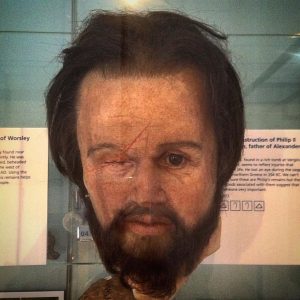
found in a rich tomb at Vergina in northern Greece
Image source:https://search.creativecommons.org/photos/ae434ef2-1b8f-4195-abc6-418d4b6992eb Author:akhenatenator
Where is the final resting place of king Philip?
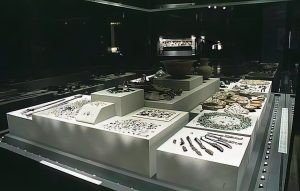
Image source: https://en.wikipedia.org/wiki/Vergina#/media/File:Macedonian_Museums-42-Arx_Bas_Tafoi_Berginas-185.jpg
Archaeologists who excavated the tomb of the king at Vergina, Greece, in the 1977-1978 came to the conclusion that it was the burial place of Philip II of Macedon. But in fact some new evidence suggests his remains were buried in a nearby tomb. New study appears to solve a long-standing debate in Greek archaeology. Found that skeletal analysis of the leg bones from the remains of an adult male in Tomb I shows a severe lance wound that matches accounts in ancient written sources. During the battle in 339 Philip II sustained of an injury.
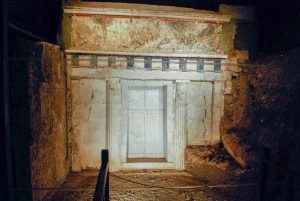
Facade of Philip II of Macedon tomb in Vergina, Greece. The door is made of marble and the order is doric.
Image source: https://en.wikipedia.org/wiki/Vergina
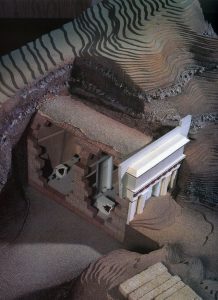
Image source:https://en.wikipedia.org/wiki/Vergina#/media/File:Makieta_grobowca_Filipa.jpg
The authors of the study argue that this not only offers the first and definitive proof of where Philip II was buried, but could also suggests that some of the grave goods in Tomb II may belong to Alexander the Great. The team of Spanish and Greek archaeologists is the first to analyze the remains of the three skeletons in Tomb I. Was found that the bones belong to a middle-aged man, a young woman and a newborn infant of unknown sex. The forensic evidence confirms the ages-at-death reported in ancient literary sources for Philip II and also the last of his seven wives, as well as their their infant child. The leg bones of the male from Tomb I show a huge hole in his left knee. There are no evident signs that are characteristic of infection and osteomyelitis. This facts indicates that the injury was likely caused by a grave penetrating wound to the knee, which resulted in an active inflammatory process that stopped years before death.
The “Great Tumulus”
The Great Tumulus was uncovered in 1977 and this important discovery put Vergina on the map as an essential archaeological site. In 1993 was inaugurated the museum of the tumulus of Philip and it was built over the tombs. Internal of that place there are four tombs and one small temple. One of them “Heroon” was built as the temple for the burial cluster of the king Philip II. Other two most important tombs (II and III) were remained unlooted and contained an exceptional amount of grave goods. Tomb number II was separated in two rooms, in the main room included a marble chest with 24 carat of gold. Another chest with golden “larnax” was located in the antechamber and was containing the bones of a woman wrapped in a purple clothes decorated golden elements with a wonderful diadem embellished with some flowers and enamel.
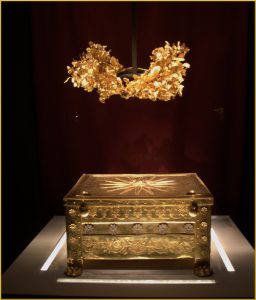
Image source: https://en.wikipedia.org/wiki/Vergina#/media/File:Vergina_2.jpg
Info source: https://en.wikipedia.org/wiki/Philip_II_of_Macedon
https://en.wikipedia.org/wiki/Vergina
https://www.brown.edu/Departments/Joukowsky_Institute/courses/greekpast/4818.html
